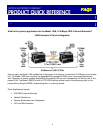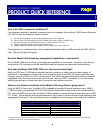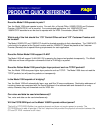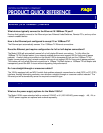
2
22
2
FAQs
FAQsFAQs
FAQs
Product Related Questions
How is the VDSL connection established?
Four steps are required to establish a communications link between the two Model 1058 Ethernet Extenders
(CO and CP) and the respective network devices.
1) Connect the 10/100Base-TX devices to the Ethernet port of each 1058 unit.
2) Connect the POTS/ISDN device to the POTS/ISDN port of each 1058 unit (1058DV only)
3) Connect each end of the twisted-pair wire to the Link port of each 1058 unit.
4) Plug the 1058 power supplies into a suitable power source.
5) Plug the output jack of each power supply to the rear power jack of each 1058 unit.
Once powered up, a communications link is established between the two 1058 units and the VDSL LED on
each 1058 unit will glow solid green.
Does the Model 1058 include any management capabilities or test modes?
No, the Model 1058 does not have any management capabilities or test modes. However, it does feature
seven status LED indicators to provide operational status at a glance and assist with troubleshooting.
Why does the Model 1058 VDSL QOL/error light occasionally flash?
When the QOL/"error” LED flashes it signifies that error correction is taking place and data integrity is
maintained. It is possible for the error light to be constantly lit and the link will still function with data intact.
However, when the QOL/Error LED is continuously lit, the 1058’s are approaching their maximum distance
capabilities under the current environment and line rate. When the QOL is constantly lit, we recommend
switching the modem to a lower line rate to ensure the most reliable connection.
What are the distance limitations of the Model 1058 using different gauge wires?
Using 24 AWG (0.5 mm) wire, the Model 1058 is capable of providing Ethernet extensions up to 4,656 ft
(1.42 km) including the potential 328 ft (100 m) Ethernet connections on both ends of the communications
link. Using 26 AWG (0.4 mm) wire, the Model 1058 is capable of providing Ethernet extensions up to 3,856
ft (1.18 km). Actual distance and link performance will vary based on the environment (cross talk/noise) and
type/gauge of wire used. The chart below shows an example of how the gauge of wire affects the distance.
Approximate Distances at 12.5 Mbps (Default Setting)
Wire Gauge: AWG (mm) Distance: Feet (km)
26 AWG (0.4 mm) 3856’ (1.18 km)
24 AWG (0.5 mm) 4656’ (1.42 km)
22 AWG (0.64 mm) 5256’ (1.60 km)
20 AWG (0.81 mm) 5556’ (1.69 km)
18 AWG (1.00 mm) 5756’ (1.75 km)
16 AWG (1.29 mm) 5856’ (1.78 km)
*NOTE: Distances are based on a minimum to no cross talk environment. This distance table includes the potential 328ft (100 m) Ethernet
connections on both ends of the communications link.






